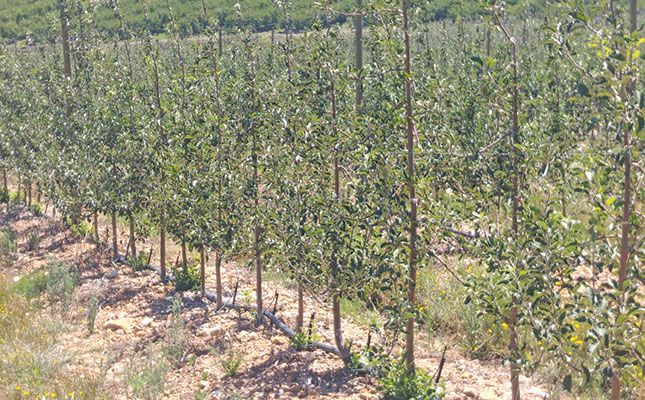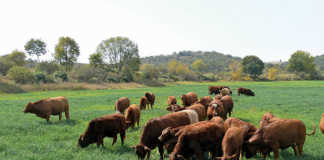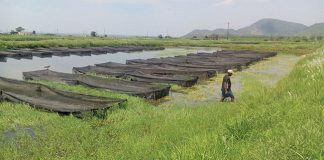
Photo: Supplied
Glyphosate is considered an indispensable weed-management tool for both fruit and grain producers. However, it has recently become associated with a number of problems in crop production.
James Dick, co-owner of DNS Crop Institute, says that in certain Grabouw orchards, he has noticed a decline in production, as well as chlorosis and retarded growth in the apical reaches of some trees. Individual trees in orchards growing in heavier soils also exhibit typical symptoms of trace element deficiency.
While the exact cause of these problems is complex and uncertain, Dick suspects that glyphosate might be a major contributing factor.
“Glyphosate was originally developed by Stauffer Chemical in the 1960s as a chelating agent, which means it can bond to metal elements such as iron, manganese, zinc, calcium, nickel and copper. Monsanto then patented it as a herbicide in 1974,” says Dick.
Glyphosate kills plants by blocking a critical enzyme pathway known as the shikimic acid pathway. The enzyme is essential for plant respiration, so a plant that receives a full dose of glyphosate cannot survive unless it is engineered or evolves to be resistant. Glyphosate also weakens a plant’s defences against infectious organisms.
Trials and analysis
Dick says that apart from compromising a plant’s defences and increasing pathogen populations and virulence, glyphosate can have indirect effects on the plant’s predisposition to diseases. These include reducing its growth and vigour, altering its physiological efficiency, and modifying the soil microflora that affect the availability of nutrients involved in physiological disease resistance.
“Having followed international [research] on the impact of glyphosate on orchard production, especially [that of] Dr Don Huber, a former professor of plant pathology at Purdue University in the US, I decided to have the roots of trees in three problem orchards in Elgin analysed. This revealed that two orchards were affected by glyphosate contamination,” says Dick.
The third had not been sprayed with glyphosate.
Following this discovery, Dick conducted a home-based trial to evaluate the impact of glyphosate contamination on plant growth. He collected random soil samples from glyphosate application strips under tree canopies in three pome fruit orchards in Grabouw that showed signs of decline. Two of the orchards had clay soils and a low pH, and the third had sandy soil and a higher pH.
As a control, soil was randomly collected from the tractor row in an orchard where glyphosate was not used.
The collected samples were placed in 24 pots (four pots containing soil from each of the three glyphosate-treated locations, and 12 control pots). Runner beans were then planted and cultivated in the pots for four weeks. Only 12 runner beans germinated: 11 beans in the control pots and just one bean in the glyphosate-treated soil, which Dick considers a clear indication that glyphosate can suppress growth.
Interestingly, the single plant that germinated in the glyphosate-treated soil did so in sandy soil.
“Absorption of glyphosate was less in the sandy soil than in the clay, and it was therefore subject to microbial degradation, which is why germination was better [here],” says Dick.
Contamination
Glyphosate enters soil via direct application and spray drift, as well as from root exudates of plants that have absorbed the herbicide. “Under normal conditions and when used correctly, glyphosate should break down within six months through microbial degradation,” explains Dick.
Accumulation is exacerbated in acidic and clay soils. “The problem has been found to be more severe in heavy clay soils than in lighter soils, as glyphosate chelates with cations in the former. It’s also worse in acidic soils, as glyphosate is desorbed by phosphorus,” he adds.
“Glyphosate contamination is associated with progressive loss of vigour, flower bud abortion, diminishing root volume, chlorosis and poor growth/budbreak in the apical reaches of the tree.
“The contamination may cause a range of problems stemming from the destruction and disturbance of important synergistic soil flora and other soil fertility processes, and/or the tying up of important minerals involved in triggering the tree’s immune system,” says Dick.
Deactivation
To prevent glyphosate contamination, avoid using the chemical, advises Dick. “If you must use it, do so according to instructions. Vary it with herbicides with other modes of action to prevent a build-up of glyphosate in the soil and plant tissues.”
When problems with budbreak, root and apical growth occur, have the affected orchards and soils analysed to identify whether the cause is glyphosate contamination. If it is, ensure that there are adequate levels of calcium, magnesium and micro-elements in the soil and trees to detoxify the glyphosate.
In addition, phosphate fertiliser should be used judiciously, as it can reactivate glyphosate in the soil. Humates, however, can be used to counter this effect. Zinc can also be added to formulations to detoxify the glyphosate.
Glyphosate has the greatest impact on the roots of the tree, severely restricting its ability to absorb nutrients, including phosphate. Farmers therefore have to fertilise more often and include trace elements if necessary.
Cover crops
While soil type (sand, silt or clay) in an orchard is important, another aspect that should be considered is fractal geometry, a potential new way of analysing the root architecture in soil.
“Roots, hyphae and humus have massive surface areas, and the greater the surface area, the more opportunity for biochemical reactions to occur. Also, the more diverse the biome, the more synergy and efficiency occur,” explains Dick.
Some plant root systems produce protective compounds called plant secondary metabolites. If these plants are grown as cover crops, they could potentially offer incidental protection if grown in the immediate vicinity of the primary crop.
Planting a wide mixture of cover crops will maximise their beneficial impact on the soil, as each crop has its own advantages. Oats, for instance, exude allelopathic compounds that suppress diseases and weeds.
“You need diversity, as this will also help to create a diverse population of soil organisms that can keep each other in check,” says Dick.
Email James Dick at [email protected].










